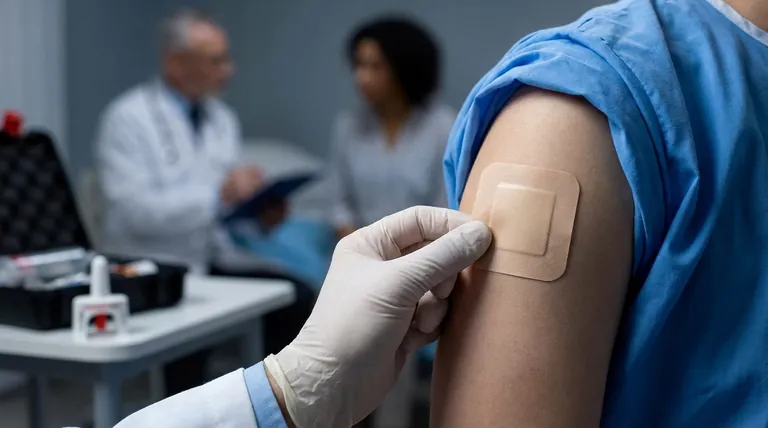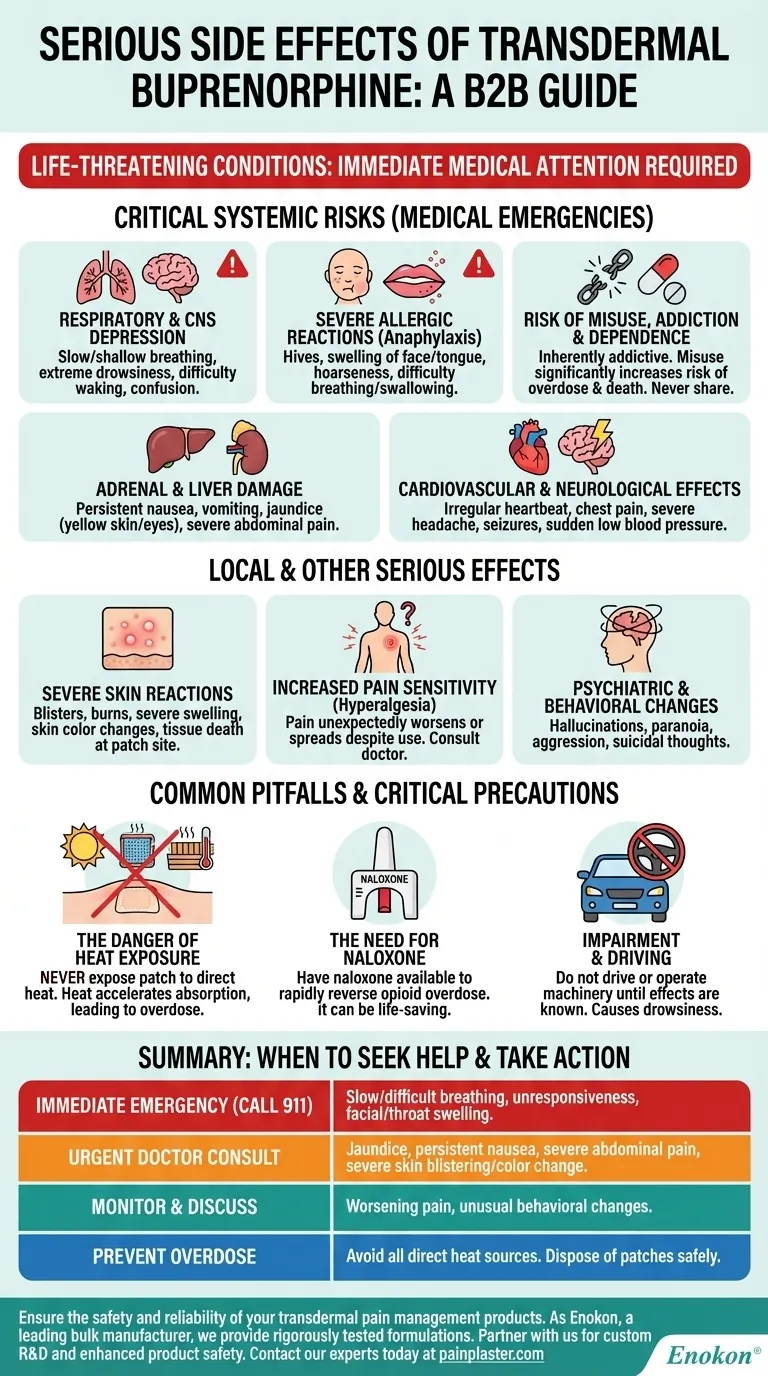The most serious side effects of transdermal buprenorphine are life-threatening conditions that require immediate medical attention. These include severe breathing problems (respiratory depression), central nervous system depression, risk of misuse and addiction, severe allergic reactions, and potential liver damage. Recognizing the signs of these effects is critical for safe use.
While effective for managing severe pain, transdermal buprenorphine is a powerful opioid with significant risks. Understanding how to identify a serious adverse reaction is the most important step you can take to ensure your safety or the safety of someone in your care.

Critical Systemic Risks: When to Seek Immediate Help
The most dangerous side effects of buprenorphine affect your entire body, particularly your respiratory and central nervous systems. These are medical emergencies.
Central Nervous System (CNS) and Respiratory Depression
This is the most life-threatening risk associated with any opioid. The medication can slow or stop your breathing and significantly impair brain function.
Symptoms include difficulty breathing, shallow breathing, extreme drowsiness, confusion, or an inability to respond or wake up.
Severe Allergic Reactions
A systemic allergic reaction (anaphylaxis) can occur and progress rapidly. It requires immediate emergency intervention.
Look for signs like hives, widespread itching, swelling of the face, lips, or tongue, hoarseness, and difficulty breathing or swallowing.
Risk of Misuse, Addiction, and Dependence
As an opioid, buprenorphine carries an inherent risk of physical dependence and addiction, even when used exactly as prescribed by a doctor.
Misuse significantly increases the likelihood of all serious side effects, including overdose and death. This medication should never be shared.
Adrenal and Liver Damage
Buprenorphine can impact organ function, leading to serious complications. Adrenal insufficiency and liver damage are two key concerns.
Symptoms of adrenal problems include persistent nausea, vomiting, appetite loss, and dizziness. Signs of liver damage can include jaundice (yellowing of the skin or eyes) and severe abdominal pain.
Cardiovascular and Neurological Effects
The medication can have a direct impact on your heart and brain.
Seek immediate medical attention for symptoms like an irregular heartbeat, chest pain, severe headache, stiff neck, seizures, or sudden low blood pressure that causes fainting.
Understanding Local and Other Serious Effects
Beyond systemic risks, you must monitor for severe reactions at the application site and be aware of other potential complications.
Severe Skin Reactions
While mild redness is common, a severe reaction at the patch site is a serious concern.
Watch for severe redness, swelling, blisters, burns, or skin color changes where the patch was worn. In rare cases, this can lead to necrosis, or tissue death.
Increased Pain Sensitivity
Paradoxically, long-term opioid use can sometimes make your body more sensitive to pain, a condition known as opioid-induced hyperalgesia.
If your pain unexpectedly worsens or spreads despite using the medication, discuss it with your doctor immediately.
Psychiatric and Behavioral Changes
Buprenorphine can affect mood and perception, sometimes severely.
Hallucinations, paranoia, aggression, unusual changes in behavior, or any thoughts of suicide are serious side effects that require immediate medical consultation.
Common Pitfalls and Critical Precautions
Avoiding serious side effects involves more than just monitoring symptoms; it requires strict adherence to safety protocols.
The Danger of Heat Exposure
Never expose the patch to heat from sources like heating pads, electric blankets, saunas, or prolonged direct sunlight.
Heat dramatically increases the rate at which the medication is absorbed into your bloodstream, which can easily lead to a life-threatening overdose.
The Need for Naloxone
Given the risk of opioid overdose, it is wise for patients and their families to have naloxone available and know how to use it.
Naloxone is a medication that can rapidly reverse an opioid overdose and can be life-saving.
Impairment and Driving
Do not drive, operate heavy machinery, or perform other dangerous tasks until you know how the medication affects you.
Buprenorphine can cause significant drowsiness and impair your judgment and reaction time.
Making the Right Choice for Your Goal
Recognizing the difference between a minor issue and a medical emergency is key to using transdermal buprenorphine safely.
- If your primary focus is recognizing an immediate emergency: Watch for any signs of slowed or difficult breathing, unresponsiveness, or swelling of the face and throat, and call 911 immediately.
- If your primary focus is monitoring for organ damage: Pay close attention to jaundice (yellow skin/eyes), persistent nausea, or severe abdominal pain and contact your doctor right away.
- If your primary focus is patch site safety: Differentiate between mild irritation and severe blistering, swelling, or skin color changes, and consult your doctor if the reaction is severe.
- If your primary focus is preventing accidental overdose: Absolutely avoid exposing the patch to any direct heat source and ensure proper patch disposal to protect children and pets.
Your ability to stay informed and vigilant is the most powerful tool for ensuring your treatment is both effective and safe.
Summary Table:
| Serious Side Effect | Key Symptoms to Watch For |
|---|---|
| Respiratory/CNS Depression | Slow/shallow breathing, extreme drowsiness, unresponsiveness |
| Severe Allergic Reaction | Swelling of face/lips/tongue, hives, difficulty breathing |
| Liver Damage | Jaundice (yellow skin/eyes), severe abdominal pain |
| Severe Skin Reaction | Blisters, burns, swelling, or skin color changes at patch site |
| Cardiovascular/Neurological | Irregular heartbeat, chest pain, seizures, severe headache |
Ensure the safety and reliability of your transdermal pain management products. As Enokon, a leading bulk manufacturer of transdermal patches and pain plasters, we provide healthcare and pharma distributors and brands with rigorously tested, reliable formulations. Our technical expertise supports custom R&D to develop patches that prioritize patient safety. Partner with us to enhance your product line — contact our experts today to discuss your development needs.
Visual Guide

Related Products
- Far Infrared Deep Heat Relief Patches Medicated Pain Relief Patches
- Far Infrared Pain Patch Relief Pain Reliever for Back
- Far Infrared Knee Pain Patch Heat Patches for Pain Relief
- Far Infrared Heat Pain Relief Patches Transdermal Patches
- Asthma Cough and Pain Relief Patch for Adults and Kids
People Also Ask
- How effective are pain relief patches for muscle pain? Target Localized Pain with Transdermal Delivery
- How does the Deep Heat Back Patch work? A Drug-Free Solution for Targeted Pain Relief
- How do pain relief patches compare to other pain relief methods? Discover Targeted, Long-Lasting Relief
- How do Deep Heat Pain Relief Patches provide pain relief? Discover the Drug-Free Mechanism
- How should pain relief patches be applied and used? A Guide to Safe & Effective Targeted Relief













